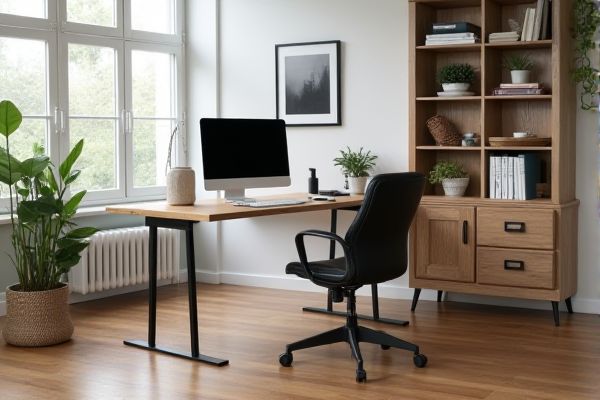
A rolling desk offers mobility and flexibility, allowing you to easily reposition your workspace to adapt to different tasks or environments, while a stationary desk provides a stable, fixed surface ideal for focused, consistent work. Explore the rest of this article to discover which desk style best suits your productivity and comfort needs.
Table of Comparison
| Feature | Rolling Desk | Stationary Desk |
|---|---|---|
| Mobility | High - Easy to move and reposition | Low - Fixed in one place |
| Flexibility | Adaptable for multiple workspaces | Designed for a single, consistent setup |
| Stability | Moderate - May wobble on uneven surfaces | High - Firm and sturdy |
| Space Efficiency | Typically smaller footprint | Can be bulkier with added storage |
| Use Case | Ideal for dynamic environments and shared spaces | Best for dedicated work areas |
| Cost | Generally less expensive | Often higher price due to materials and design |
Introduction to Rolling and Stationary Desks
Rolling desks offer enhanced mobility with caster wheels, allowing you to easily move and reposition your workspace for flexible use and better ergonomics. Stationary desks provide a stable, fixed setup, ideal for demanding tasks that require a solid, unmoving surface and durability. Choosing between rolling and stationary desks depends on your workspace needs, mobility preferences, and how often you rearrange your office environment.
Key Features of Rolling Desks
Rolling desks offer mobility with built-in caster wheels, allowing you to easily reposition your workspace for flexibility and convenience. Many models feature adjustable height settings and locking mechanisms on the wheels to provide stability when needed. These desks enhance productivity by accommodating various tasks and environments while maintaining ergonomic support.
Main Characteristics of Stationary Desks
Stationary desks are defined by their fixed position, offering stability and durability with no wheels or casters, making them ideal for long-term, consistent workspace setups. Typically constructed from solid wood, metal, or composite materials, they provide a sturdy surface capable of supporting heavy equipment like monitors and desktop computers. The lack of mobility enhances ergonomic customization options such as adjustable height or integrated storage, promoting efficient organization and focused productivity.
Mobility and Flexibility Comparison
Rolling desks provide superior mobility, allowing you to easily reposition your workspace to adapt to changing tasks or room layouts. Stationary desks offer stability but lack the flexibility to move, limiting your ability to reconfigure your environment quickly. Choosing a rolling desk enhances flexibility for dynamic work settings, while stationary desks suit fixed arrangements requiring lasting steadiness.
Space-Saving Benefits
Rolling desks offer superior space-saving benefits by enabling easy mobility and flexible room arrangements, which allows users to quickly reconfigure workspaces to maximize available floor area. Stationary desks, while often more stable and sturdy, occupy a fixed footprint that can limit adaptability in compact or multi-use rooms. For small offices or shared environments, rolling desks optimize spatial efficiency by facilitating effortless repositioning and storage.
Ergonomics and Comfort Differences
Rolling desks offer enhanced flexibility by allowing users to easily adjust their workspace position, which promotes better posture and reduces strain during extended use. Stationary desks provide stable support ideal for maintaining consistent ergonomic settings, such as fixed monitor height and keyboard placement, which can enhance comfort for tasks requiring precision. Ergonomically, rolling desks cater to dynamic movements and varied work styles, while stationary desks ensure a steady ergonomics foundation but may limit adaptability.
Durability and Stability Analysis
Rolling desks feature casters that may reduce overall stability, especially on uneven surfaces, potentially affecting the desk's durability under frequent movement. Stationary desks offer enhanced stability with fixed legs or bases, leading to increased durability and better resistance to wear over time. Selecting a stationary desk is preferable for environments requiring long-term structural integrity and minimal wobbling.
Best Use Cases for Each Desk Type
Rolling desks excel in dynamic work environments where mobility and flexible workspace arrangements are essential, such as collaborative offices and classrooms. Stationary desks are ideal for dedicated work areas requiring stability and organization, commonly found in home offices and traditional corporate setups. Choosing between the two depends on the need for mobility versus a fixed, ergonomic workstation.
Price Comparison and Value for Money
Rolling desks typically range from $100 to $300, offering affordability and mobility, while stationary desks vary between $150 and $500, focusing on durability and style. Rolling desks provide excellent value for money in small spaces or for users requiring flexibility, whereas stationary desks deliver long-term investment benefits through sturdier construction and ergonomic designs. Choosing between these desks depends on budget constraints and priorities for portability versus stability.
Which Desk Should You Choose?
Choosing between a rolling desk and a stationary desk depends on your workspace needs and mobility preferences. Rolling desks offer flexibility and ease of repositioning, ideal for dynamic environments or shared spaces, while stationary desks provide stability and durability, making them suitable for permanent work setups. Consider factors like space constraints, frequency of moving the desk, and ergonomic requirements to determine the best fit for your productivity and comfort.
 homyna.com
homyna.com